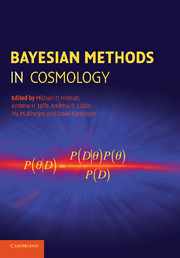Book contents
- Frontmatter
- Contents
- List of contributors
- Preface
- Part I Methods
- 1 Foundations and algorithms
- 2 Simple applications of Bayesian methods
- 3 Parameter estimation using Monte Carlo sampling
- 4 Model selection and multi-model inference
- 5 Bayesian experimental design and model selection forecasting
- 6 Signal separation in cosmology
- Part II Applications
- Index
4 - Model selection and multi-model inference
Published online by Cambridge University Press: 11 April 2011
- Frontmatter
- Contents
- List of contributors
- Preface
- Part I Methods
- 1 Foundations and algorithms
- 2 Simple applications of Bayesian methods
- 3 Parameter estimation using Monte Carlo sampling
- 4 Model selection and multi-model inference
- 5 Bayesian experimental design and model selection forecasting
- 6 Signal separation in cosmology
- Part II Applications
- Index
Summary
Introduction
One of the principal aims of cosmology is to identify the correct cosmological model, able to explain the available high-quality data. Determining the best model is a two-stage process. First, we must identify the set of parameters that we will allow to vary in seeking to fit the observations. As part of this process we need also to fix the allowable (prior) ranges that these parameters might take, most generally by providing a probability density function in the N-dimensional parameter space. This combination of parameter set and prior distribution is what we will call a model, and it should make calculable predictions for the quantities we are going to measure. Having chosen the model, the second stage is to determine, from the observations, the ranges of values of the parameters which are compatible with the data. This second step, parameter estimation, is described in the cosmological context by Lewis and Bridle in Chapter 3 of this volume. In this article, we shall concentrate on the choice of model.
Typically, there is not a single model that we wish to fit to the data. Rather, the aim of obtaining the data is to choose between competing models, where different physical processes may be responsible for the observed outcome. This is the statistical problem of model comparison, or model selection. This is readily carried out by extending the Bayesian parameter estimation framework so that we assign probabilities to models, as well as to parameter values within those models.
- Type
- Chapter
- Information
- Bayesian Methods in Cosmology , pp. 79 - 98Publisher: Cambridge University PressPrint publication year: 2009
- 3
- Cited by

